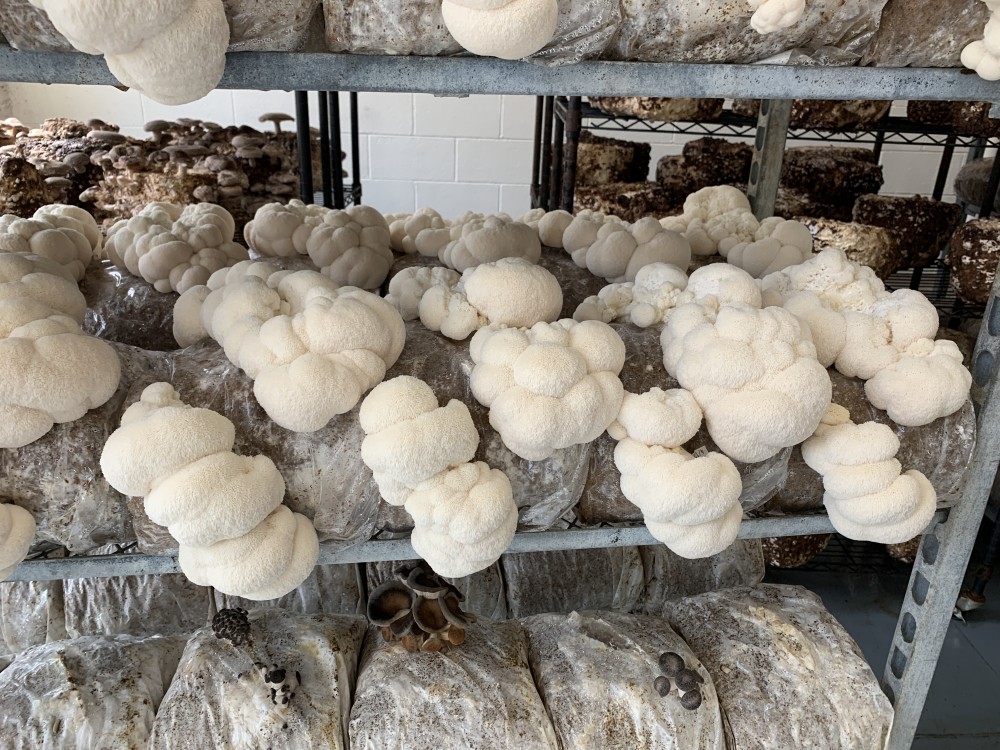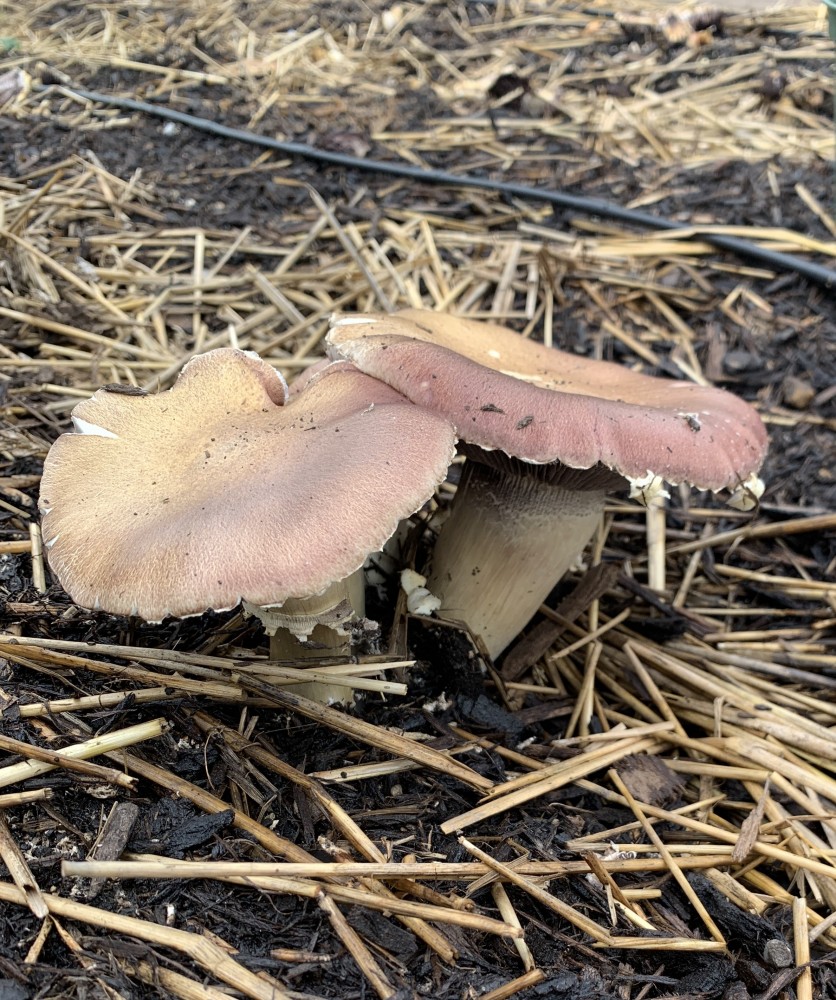Things to Consider When Adding Specialty Mushrooms to Your Farm
Lori Koenick, Extension Support Specialist
Cornell Vegetable Program
Let's set aside the familiar button, cremini, and portabella mushrooms (all in the same species of Agaricus mushrooms) and focus on a different and growing segment of the mushroom industry: specialty mushrooms. The USDA defines "specialty mushrooms" as any non-Agaricus mushroom, which includes Shiitake, Oyster, Lion's Mane, and many more.
Specialty mushroom production benefits include new income sources, crop diversification, utilization of unused space or waste streams, and building soil health. These mushrooms are grown in a variety of low-cost ways in outdoor, indoor, and hybrid systems including on logs, in the ground, in raised beds, or in blocks contained in buckets or plastic bags. Crops are sold fresh, dry, powdered, or incorporated into value-added products.
Like plants, mushrooms need specific environmental conditions to form, but sunlight is not a necessity. Humidity, temperature, and air flow are the most important considerations.
Mushrooms are neither plants nor animals but in their own unique group of organisms called fungi. A mushroom is the fruit of a fungus. Underneath the mushroom is the branching, thread-like, main body of the organism called mycelia. To be able to grow mushrooms, we first need to grow healthy mycelia. Once we have a healthy mycelia base, then we can focus on the fruiting process to get mushrooms to form.
Let's define some common mushroom cultivation terms:
- Substrate: Food source for the mushroom—common substrates include logs, straw, sawdust, wood chips, compost, hardwood pellets, and combinations of such.
- Spawn: A mixture of mycelia and substrate used to inoculate (plant) a new mushroom crop—common forms are grain, sawdust, and plugs (wooden dowels).
The general process of growing specialty mushrooms is like growing vegetables. Basic steps include:
- Spawn and strain selection: "variety selection"—Decide what type of mushroom to grow and which strain (variety) of the mushroom type. Spawn providers can be excellent sources of information.
- Substrate preparation: "bed preparation"—Specifics depend on the substrate, and vary from chopping logs, pasteurizing straw, mixing and sterilizing block materials, and more.
- Inoculation: "planting"—This involves mixing the spawn with the substrate. Drilling and filling logs with plugs or sawdust spawn is one example.
- Spawn Run: This is the incubation growth stage where mycelium colonizes and grows throughout the substrate.
- Fruiting: The growth stage where mushrooms are produced and then harvested.
Growing Oysters on straw blocks, Shiitake on logs, or Wine Caps in beds are common ways to begin exploring how to add mushrooms to your farm. When thinking about what type of mushroom to grow, consider the resources you have access to and the type of growing space you plan to use.
Indoor production consists of incubating and fruiting blocks in buildings and greenhouses using plastic bags, buckets or similar containers. Similar to controlled environment agriculture, indoor mushroom production offers the opportunity to grow more types of mushrooms year-round, producing higher and more reliable yields. Yet, indoor production can be more energy intensive, requires close monitoring of environmental conditions, and growing spaces must be kept cleaner than outdoor production due to higher contamination risk.
 Mushroom blocks fruiting in an indoor grow room, Lion's Mane mushrooms featured in the center.
Mushroom blocks fruiting in an indoor grow room, Lion's Mane mushrooms featured in the center.Outdoor production involves growing on logs, totems, or in beds. It can be done anywhere with some shade, humidity, and good airflow. Woodlots are a great option. It typically has lower costs with less infrastructure investment and energy usage, yet mushrooms can take longer to grow and produce less yield.
 Wine Cap mushrooms fruiting in raised bed.
Wine Cap mushrooms fruiting in raised bed.It does not have to be an either/or situation—growers are constantly experimenting with hybrid environments, such as growing Wine Cap beds in high tunnels or keeping fruiting logs indoors for better pest protection. Just as with growing vegetables, there is no one right way to grow mushrooms and you must figure out what works best for your farm. Experimentation is encouraged!
Things to Consider When Adding Specialty Mushrooms to Your Farm (pdf; 278KB)

Upcoming Events
Vegetable Pest and Cultural Management Field Meeting for Auction Growers -- Ontario Produce Auction
July 15, 2025
Stanley, NY
This evening meeting will demonstrate pest management in fresh market vegetables in both field and greenhouse (high tunnel) vegetables, primarily for those growing for wholesale auction. A hands-on demonstration of weed, insect and disease identification in vegetables including management options. Details on each topic will focus on field observations at the farm.
Orleans Summer Vegetable Meeting, 2025
July 16, 2025
Waterport, NY
Meeting themes are pest management in a wide array of produce and best practices for pesticide use. Professor Brian Nault will cover allium leaf miner and thrips in onions, garlic, and leeks, and discuss insect challenges in other crops. Bring your questions! We'll also have a field walk that includes high tunnel tomato and cucumber.
DEC credits available: 0.5 in CORE plus either 1.25 in 1a and 23, or 0.75 in 24.
Vegetable Pest and Cultural Management Field Meeting for Auction Growers -- Finger Lakes Produce Auction
July 18, 2025
Penn Yan, NY
This evening meeting will demonstrate pest management in fresh market vegetables in both field and greenhouse (high tunnel) vegetables, primarily for those growing for wholesale auction. A hands-on demonstration of weed, insect and disease identification in vegetables including management options. Details on each topic will focus on field observations at the farm.


































